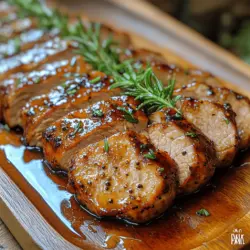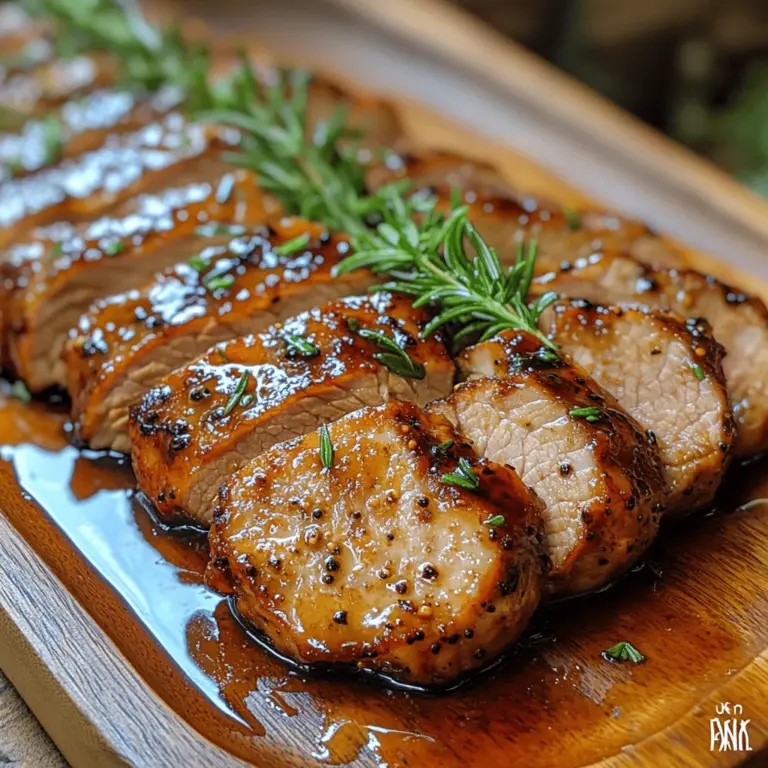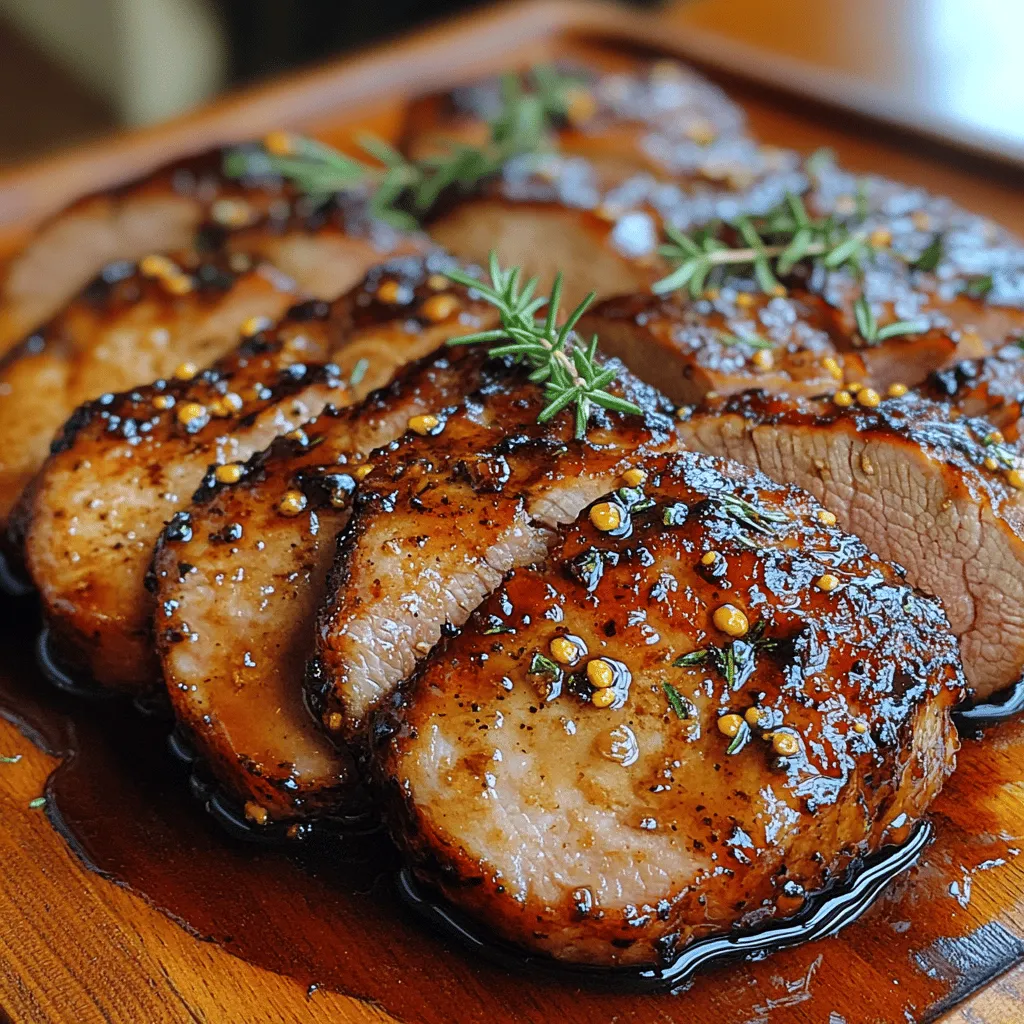Introduction
If you’re searching for a dish that perfectly balances sophistication and ease of preparation, look no further than Balsamic-Glazed Pork Tenderloin. This delightful recipe boasts a rich, tangy glaze that caramelizes beautifully, creating a mouthwatering crust on a tender, juicy cut of meat. Pork tenderloin is celebrated for its remarkable tenderness and culinary versatility, making it an excellent choice for any occasion, from casual family dinners to elaborate holiday gatherings and special celebrations.
What makes this dish truly stand out is the interplay of flavors. The balsamic glaze, enhanced by a touch of honey and a blend of fresh herbs, transforms the pork into a flavorful centerpiece that will impress your guests and satisfy your taste buds. The balance of sweetness from the honey, acidity from the balsamic vinegar, and the aromatic quality of herbs creates a harmonious dish that is as delicious as it is visually appealing.
Understanding Pork Tenderloin
Pork tenderloin is a cut of meat that comes from the muscle that runs alongside the backbone of the pig. It is renowned for its tenderness and mild flavor, making it a favorite among home cooks and professional chefs alike. Unlike tougher cuts of pork, which may require longer cooking times and specific preparation methods, pork tenderloin cooks quickly and stays juicy, making it an ideal choice for busy weeknights or last-minute dinner parties.
Nutritional Benefits of Pork Tenderloin
In addition to its culinary appeal, pork tenderloin is a nutritional powerhouse. It is a lean cut of meat, meaning it has less fat compared to other pork cuts such as ribs or shoulder. A 3-ounce serving of pork tenderloin contains approximately 120 calories, 22 grams of protein, and only 3 grams of fat, making it a great option for those looking to maintain a healthy diet. Furthermore, pork tenderloin is rich in essential nutrients like thiamin, niacin, vitamin B6, and selenium, all of which contribute to overall health and well-being.
Comparison with Other Cuts of Pork
When comparing pork tenderloin to other cuts of pork, its tenderness is a key differentiator. Cuts like pork shoulder and ribs, while flavorful, require longer cooking times and specific techniques to break down the tougher fibers. In contrast, pork tenderloin can be quickly roasted, grilled, or sautéed, making it a convenient choice for weeknight meals. Its mild flavor also allows for a wide variety of seasonings and marinades, making it adaptable to numerous cuisines and culinary styles.
Ingredients Breakdown
To create a delicious Balsamic-Glazed Pork Tenderloin, you’ll need a selection of high-quality ingredients that will enhance the final dish’s flavor and texture. Here’s a closer look at the key components of this recipe:
Overview of Key Ingredients
1. Pork Tenderloin: Choose a fresh, high-quality pork tenderloin for the best results. Look for a cut that is pink in color with a small amount of marbling, which adds flavor and moisture during cooking.
2. Balsamic Vinegar: The star of the glaze, balsamic vinegar brings a rich, tangy sweetness that complements the pork beautifully. Opt for a high-quality balsamic vinegar for the best flavor.
3. Honey: Adding a touch of honey balances the acidity of the balsamic vinegar, creating a beautifully caramelized glaze. It also enhances the overall flavor profile of the dish.
4. Fresh Herbs: Fresh herbs such as rosemary, thyme, or sage elevate the dish’s freshness and complexity. While dried herbs can be used in a pinch, fresh herbs provide a more vibrant flavor.
5. Garlic: Garlic adds depth to the marinade, infusing the meat with a savory aroma. It also offers health benefits, including immune support and heart health.
6. Olive Oil: A splash of olive oil in the marinade ensures the meat stays moist and tender during cooking while providing a rich flavor.
7. Chicken Broth: Used for basting, chicken broth adds moisture and enhances the overall richness of the dish.
Importance of Using High-Quality Ingredients
The quality of your ingredients can significantly affect the final outcome of the dish. Using high-quality balsamic vinegar and honey will ensure that the glaze is not only flavorful but also has a pleasing consistency. Fresh herbs contribute a brightness that dried herbs simply cannot replicate, making them a worthwhile investment when preparing this recipe. Additionally, selecting fresh, high-quality pork tenderloin will guarantee a succulent and satisfying meal.
Marination Process
Marinating is a crucial step in preparing Balsamic-Glazed Pork Tenderloin. It enhances the flavor of the meat and helps tenderize it, resulting in a dish that is both flavorful and juicy. Here’s a step-by-step guide to marinating your pork tenderloin:
Importance of Marinating
Marinating serves several essential purposes. It allows the flavors of the marinade to penetrate the meat, enhancing its taste and tenderness. The acid in the balsamic vinegar helps to break down the proteins in the pork, making it more tender while also imparting a robust flavor. Additionally, marinating the pork allows the flavors to meld together, creating a more complex taste profile.
Step-by-Step Guide to Marinating the Pork Tenderloin
1. Prepare the Marinade: In a mixing bowl, combine balsamic vinegar, honey, minced garlic, olive oil, chopped fresh herbs, and chicken broth. Whisk together until well combined.
2. Trim the Tenderloin: If necessary, trim any excess fat or silver skin from the pork tenderloin to ensure it cooks evenly.
3. Marinate the Pork: Place the pork tenderloin in a resealable plastic bag or a shallow dish. Pour the marinade over the pork, ensuring it is well coated. Seal the bag or cover the dish tightly.
4. Refrigerate: Allow the pork tenderloin to marinate in the refrigerator for at least 1 hour, but ideally for 4 to 6 hours. For the best flavor, marinate overnight.
Recommended Marination Time for Optimal Flavor Absorption
While marinating for just an hour can impart some flavor, allowing the pork tenderloin to marinate for several hours or overnight is recommended for optimal flavor absorption. This extended time allows the ingredients to penetrate the meat fully, resulting in a more flavorful and tender dish.
Tips for Marinating
– Resealable Bags vs. Shallow Dishes: Using a resealable plastic bag can be advantageous as it allows for better contact between the marinade and the meat. It also takes up less space in the refrigerator. However, if you prefer a shallow dish, ensure that the pork is fully submerged in the marinade.
– Turn Occasionally: If you’re marinating in a dish, turn the pork tenderloin occasionally to ensure even distribution of the marinade.
– Do Not Over-Marinate: While marinating is essential, avoid leaving the pork in acidic marinades for too long, as it can lead to a mushy texture. Stick to the recommended time for the best results.
By following these initial steps, you’ll be well on your way to creating a mouthwatering Balsamic-Glazed Pork Tenderloin that is sure to impress your family and friends. Stay tuned for the next part where we’ll delve into the cooking techniques that will elevate this dish to perfection.
Preheating the Oven: Why It Matters for Even Cooking
Before you begin the cooking process, preheating your oven is a crucial step that should never be overlooked. Preheating ensures that your pork tenderloin cooks evenly throughout, allowing the exterior to develop that beautiful golden crust while keeping the inside juicy and tender. When you place your meat in a cold oven, the temperature will fluctuate, leading to uneven cooking. Aim for a temperature of 400°F (200°C) for this recipe, as it strikes the perfect balance between searing and roasting. Once the oven reaches the desired temperature, you’ll be ready to take the next step.
Searing the Pork: The Science Behind Creating a Golden Crust
Searing the pork tenderloin is not just about aesthetics; it plays a significant role in flavor development. When you sear the meat in a hot skillet, the Maillard reaction occurs, where proteins and sugars react under high heat to create a rich, complex flavor and a crispy crust. Start by heating a tablespoon of olive oil in a heavy-bottomed skillet over medium-high heat. Once the oil is shimmering, carefully place the marinated pork tenderloin in the pan. Sear each side for about 3-5 minutes until a golden-brown crust forms. This step not only locks in moisture but also adds depth to the overall flavor of the dish.
Oven-Roasting: Achieving the Perfect Internal Temperature
After searing, transfer the pork tenderloin to the preheated oven. Roast it for approximately 20-25 minutes, or until the internal temperature reads 145°F (63°C) on a meat thermometer. This temperature ensures that the pork is safe to eat while remaining juicy. Remember to check the temperature at the thickest part of the meat for an accurate reading. Once it reaches the desired temperature, remove it from the oven and cover it loosely with aluminum foil. This resting phase allows the juices to redistribute throughout the meat, ensuring that every slice is succulent and flavorful.
Importance of Resting Meat After Cooking for Juiciness
Resting the meat after cooking is a fundamental yet often overlooked step in achieving the perfect pork tenderloin. When meat is cooked, the juices are pushed toward the center due to the heat. If you cut into the pork immediately after removing it from the oven, those juices will run out, leaving you with a dry piece of meat. Instead, let the pork rest for at least 5-10 minutes before slicing. This resting time allows the juices to settle, resulting in a tender and moist pork tenderloin that will impress your family and guests alike.
Creating the Balsamic Glaze
While the pork is resting, it’s the perfect time to create the balsamic glaze that will elevate your dish to new heights.
Steps for Reducing the Marinade into a Glaze
Begin by pouring the leftover marinade into a small saucepan. Bring it to a gentle boil over medium heat, then reduce to a simmer. As it cooks, the liquid will reduce, thickening into a glaze. This process typically takes about 10-15 minutes. Keep a close eye on the mixture to prevent burning, stirring occasionally to ensure even cooking.
The Significance of Simmering: Concentrating Flavors
Simmering is a key technique in this process, as it allows the flavors to concentrate. The heat breaks down the ingredients in the marinade, intensifying the sweetness of the balsamic vinegar and the savory notes of the garlic and herbs. As the mixture reduces, it will become syrupy, making it perfect for drizzling over the pork.
How to Achieve the Right Consistency for the Glaze
You’ll know the glaze is ready when it coats the back of a spoon and has a thicker consistency. If you desire a thicker glaze, continue simmering until it reaches your preferred thickness. Remember that the glaze will thicken slightly more as it cools, so don’t over-reduce it. Once it’s ready, remove it from the heat and set it aside while you prepare to slice the pork.
Serving Suggestions for the Glaze: Drizzling vs. Dipping
When it comes to serving the balsamic glaze, you have a couple of options. For an elegant presentation, drizzle the glaze over the sliced pork tenderloin just before serving. This not only adds visual appeal but also allows the glaze to seep into the meat, enhancing the flavors with each bite. Alternatively, you can serve the glaze on the side for dipping, allowing guests to customize their flavor experience. Either way, the glaze will add a delightful tangy sweetness that complements the savory pork beautifully.
Presentation and Serving Suggestions
Arranging the Sliced Pork on a Platter for Visual Appeal
Presentation is key when serving your Balsamic-Glazed Pork Tenderloin. Once the meat has rested and been sliced, arrange the pieces on a large serving platter. Overlap the slices slightly for a rustic look, showcasing the juicy interior and the glistening glaze.
Garnishing with Fresh Rosemary: Enhancing Aesthetics and Aroma
To elevate the visual appeal and aroma of your dish, garnish with sprigs of fresh rosemary. Not only does it add a pop of color, but the fragrant herb also enhances the overall flavor profile of the dish, creating a feast for the senses.
Pairing Ideas: Side Dishes That Complement the Flavors of the Pork
When choosing side dishes to accompany your Balsamic-Glazed Pork Tenderloin, consider options that provide balance and contrast. Creamy mashed potatoes or roasted garlic potatoes work wonderfully, absorbing the flavors of the glaze. For a fresh touch, serve with steamed green beans or a vibrant arugula salad tossed with a light vinaigrette. These sides will enhance the meal without overpowering the star of the show.
Suggested Beverages: Pairing Wine or Sides That Enhance the Meal
To complement your pork tenderloin, consider serving a glass of Pinot Noir or a light-bodied red wine. The wine’s acidity pairs beautifully with the balsamic glaze, enhancing the dish’s flavors. If you prefer white wine, a crisp Sauvignon Blanc can also work well. Additionally, a refreshing sparkling water with a slice of lemon can cleanse the palate between bites, making for a delightful dining experience.
Nutritional Information
When preparing Balsamic-Glazed Pork Tenderloin, it’s important to consider the nutritional aspects of the dish.
Breakdown of Calories, Protein, and Other Nutrients per Serving
For a typical 4-ounce serving of pork tenderloin, expect around 200 calories, with approximately 25 grams of protein and 10 grams of fat. The balsamic glaze adds minimal calories, making this dish a healthy choice for a hearty meal.
Discussion on the Health Aspects of the Ingredients Used
Pork tenderloin is one of the leanest cuts of meat, providing a great source of protein while being lower in fat than other pork cuts. Balsamic vinegar, rich in antioxidants, offers health benefits, including improved digestion and blood sugar regulation. The inclusion of herbs like rosemary not only enhances flavor but also adds to the dish’s nutritional profile.
Suggestions for Making the Dish Lighter or More Indulgent
To lighten the dish, consider serving it with a side of grilled vegetables instead of starches. Alternatively, if you’re looking to indulge, you can serve it alongside creamy risotto or a rich potato gratin. The versatility of this recipe allows you to customize it according to your dietary preferences.
Conclusion
Balsamic-Glazed Pork Tenderloin is more than just a meal; it’s an experience that delights the palate and showcases the beauty of fresh ingredients. The combination of the tender, juicy pork with a sweet and tangy glaze creates a harmonious balance of flavors that is sure to impress. Whether you’re preparing this dish for a special occasion or a cozy family dinner, it promises to be a standout centerpiece.
With its impressive presentation and delectable taste, this pork tenderloin recipe is perfect for any gathering. So why not give it a try? Embrace the joy of cooking and elevate your dining experience with this flavorful dish. The balance of flavors, the satisfaction of creating a delicious meal, and the smiles it brings to your dining table are what cooking is all about. Enjoy every moment in the kitchen, and savor the wonderful results of your efforts.


